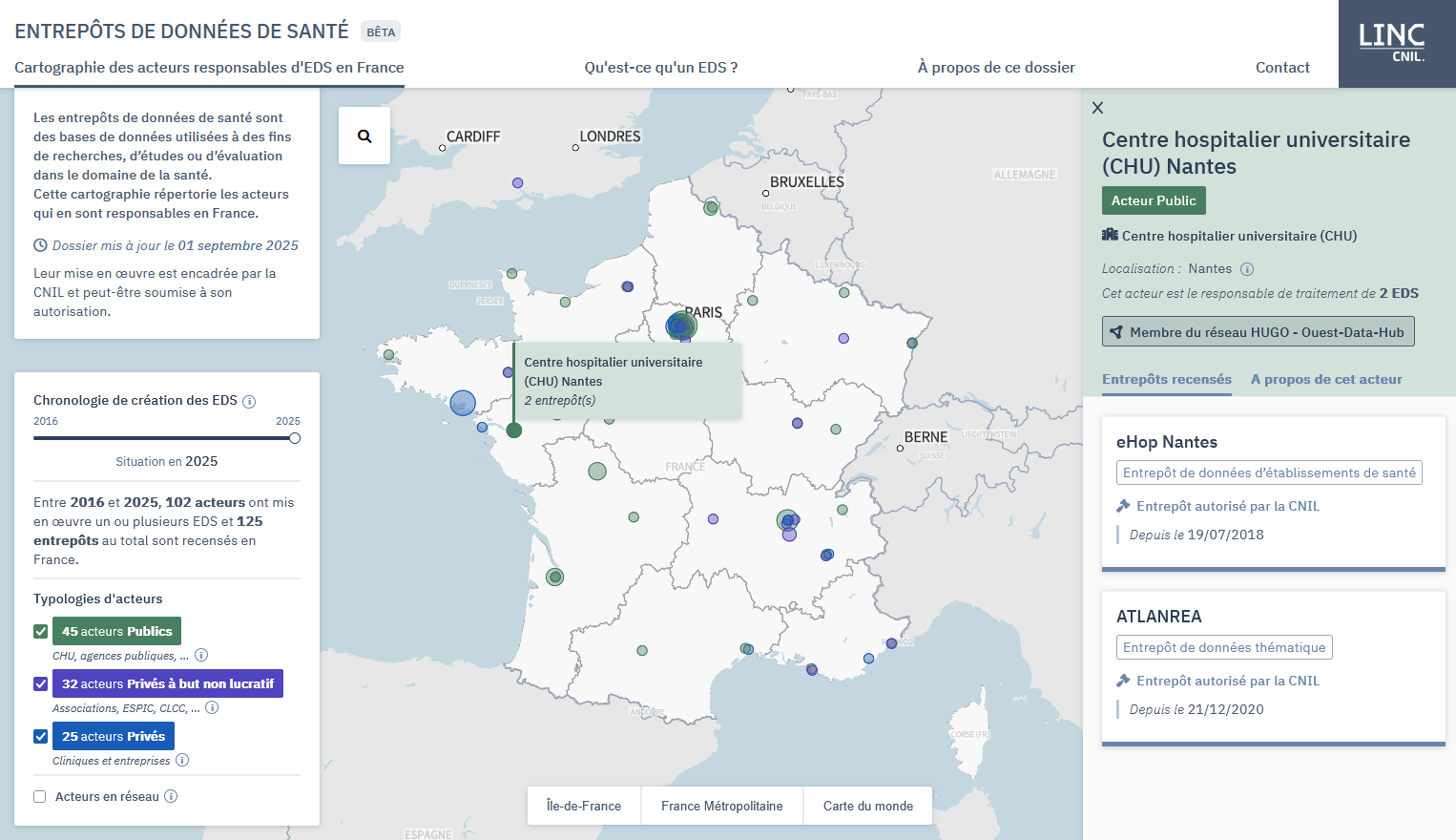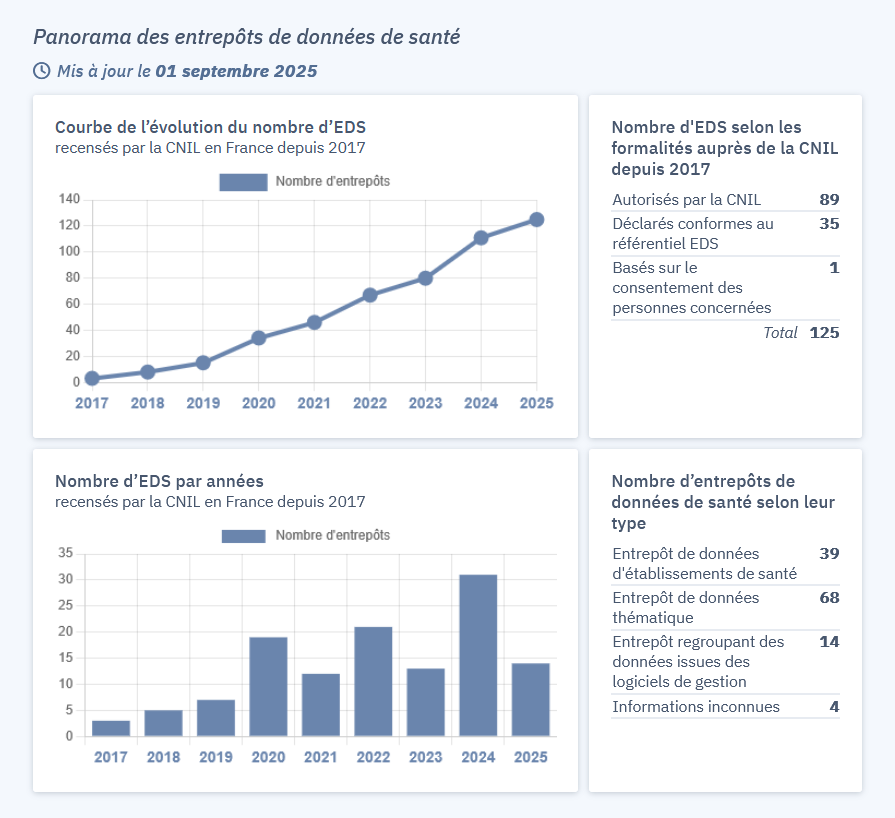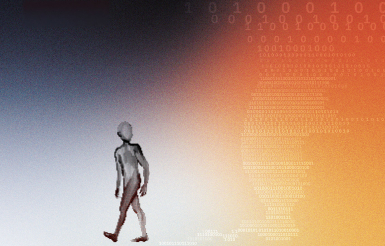[Update] – Mapping of Health Data Warehouses, 2025 Edition
Rédigé par Martin Biéri, Audrey Pety et Romain Pialat
-
18 November 2025One year after its publication, the Mapping of Health Data Warehouses (EDS in French) has been updated. This update concerns the EDS database, but also includes a more technical change (a change of tool and map background).

The Mapping of Health Data Warehouses (EDS) helps make the ecosystem of health data research in France more understandable by identifying and locating the actors setting up these warehouses. Published in October 2024, it has now been updated (up to September 1, 2025). The LINC presents the main changes in this article.
Explore the overview of Health Data Warehouses (only in French) :
- The Map of Health Data Warehouses (EDS) and Networks
- Definitions, purpose of the overview, legal framework, and landscape of EDS in France
- Methodology, resources, and glossary
- And the contact information for reporting changes or new EDS to be included
- The previous article on the state of EDS in France in 2024 : Un nouvel E(D)Spoir ? Les dynamiques à l’œuvre dans le développement des entrepôts de données de santé en France.
An update of the database
To understand the vocabulary and the different types described in this section, you can consult our dossier « What is an EDS? »
Substantively, the database has been enriched with new authorizations and new declarations of compliance with the CNIL EDS framework. In just under a year, we can count 26 new entries, including 11 new authorizations, 13 new declarations, the addition of a warehouse based on the consent of the individuals concerned. We also removed a project that had been incorrectly listed as a warehouse, which means that between the two publications, the number of warehouses increased from 100 to 125.
Regarding the consent-based EDS, this refers to the ComPaRe database of the Assistance Publique – Hôpitaux de Paris (AP-HP), which involves the reuse of data from volunteer patients (collected via a collaborative platform) and is co-led by Université Paris Cité. More generally, we can observe a slowdown in the growth of EDS creation in France: 2024 saw 31 new warehouses, compared to 14 in 2025 (figures as of September 1). Only one new network was added, the EDS@NOVA network, which brings together the University Hospitals of Bordeaux, Limoges, and Poitiers.
Regarding the types of new warehouses, we identified 9 hospital-based warehouses, 16 thematic warehouses, and no new warehouses based on the provision of software solutions. The distribution also remains consistent: among the 26 additional warehouses, 5 are public-sector stakeholders (mainly hospitals), 6 are private non-profit stakeholders (associations, mutual organizations, etc.), and 3 are private companies. As a result, an increasing number of stakeholders are managing multiple warehouses.
Geographically, we can observe an overall densification of EDS across the country. First, there is a concentration in the east, with the EDS of the CHR Metz-Thionville and two new warehouses in Dijon; but also in the southwest quarter (Poitiers, with two new EDS), one EDS in Limoges, and in Toulouse... More generally, major cities such as Paris and Lyon benefit from the development of EDS (+10 in the Paris region, +3 in the Lyon region).

Excerpt from the summary tables showing the evolution of EDS in France by year and type, from 2017 to September 2025.
A more technical update: change of mapping service and base map
The base map displayed on the site is a technical component in its own right, including native functions such as zooming and click-and-drag. Libraries exist to handle these functions and allow them to be better integrated into the code.
Mapbox
In the first version of this overview tool, we chose the Mapbox library (a U.S. company based in San Francisco), a widely used solution with extensive online documentation. This was an advantage for moving quickly, but it also came with a major drawback: in the free version, Mapbox’s servers support only a limited number of connections per month.
Furthermore, once the mapping tool was developed and stable, it seemed appropriate to carry out this technical update toward open and free solutions, allowing resources—such as the base map—to be stored locally, without having to « call » them from external sources.
MapLibre
MapLibre makes it possible to open up the overview both in terms of the choice of base map and through its open-source code. No account or access token is required, nor any externally hosted base map: MapLibre allows the integration of any base map in various formats, and therefore lets you choose your own hosting provider.
The base map
The IGN, the French National Institute of Geographic and Forest Information, offers various base maps hosted on its servers, along with tutorials on how to modify them and integrate them into an overview project. Using the Maputnik website, we were able to use a « classic » base map and modify it to highlight the geographic attributes that were relevant to us.
In this way, MapLibre retrieves the IGN maps’ native functions directly from the GeoPortail service (data.geopf.fr).
Note that a new system, also managed by the IGN, called « Carte Facile », is currently under development and could be the subject of the next technical update of our health data warehouse mapping.
MapLibre Integration
Regarding the code interfacing for the transition from Mapbox to MapLibre, the technical requirements are not particularly demanding. It is necessary to:
- Identify the calls to the Mapbox library in the JavaScript code;
- Replace all these calls with MapLibre calls, as the nomenclature is almost identical;
- Do the same for the cascading style sheets (CSS);
- Replace the Mapbox map link with the link to the new map: for example, we decided to host it directly on our servers.
The time cost of this transition is therefore not very high (a few hours for an experienced developer) and even allows for an unlimited number of connections, depending on the chosen base map. However, the change entails other tasks necessary for the transition, such as creating and adapting the base map to fit the project. In the case of our overview tool, it is more advantageous to have a rather « simplified » : base map: we do not need many layers of geographic information. These adjustment steps, prompted by the transition, can therefore take time depending on the objectives pursued.



